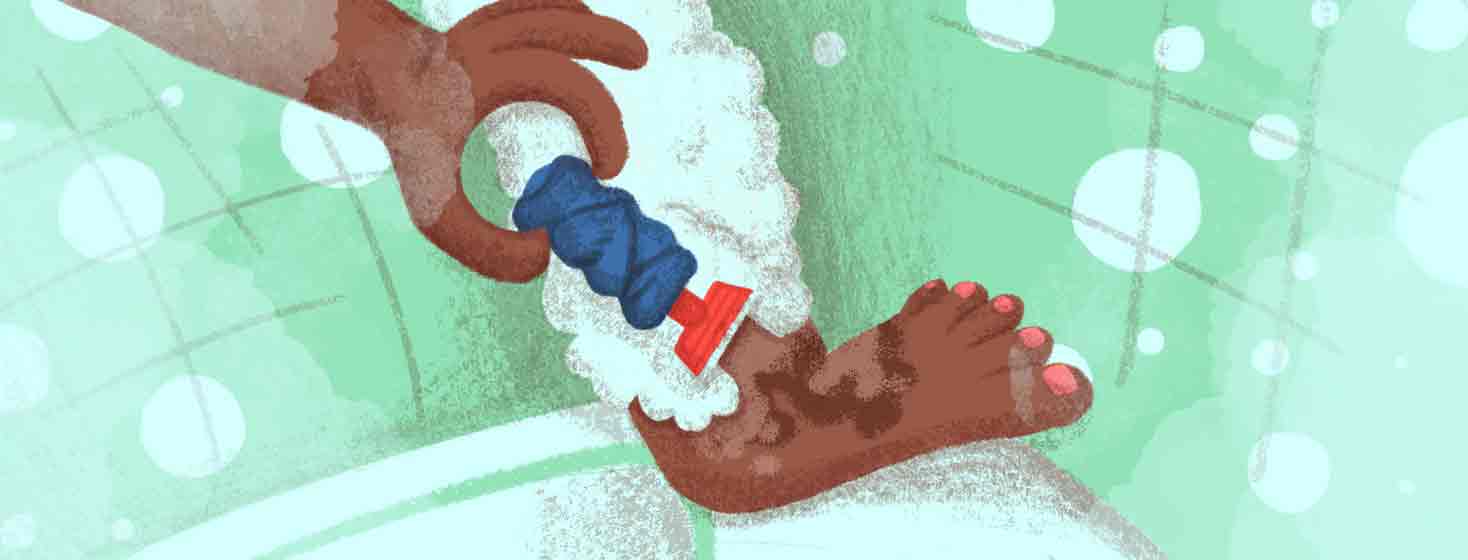Hair Removal with Psoriasis
When I was a kid I used to cover up with long-sleeved shirts and pants, even in the summer, because I was embarrassed by my guttate psoriasis. As I got older, there was an additional reason I didn’t fancy wearing shorts and skirts all the time - the hair on my legs.
Removing the unwanted beasts...
During a psoriasis flare, my legs were either one of two things: hairy or bloody (but oooh so smooth!). “Vicki, you look like a gorilla” or “Vicki, were you attacked by piranhas?” Both were exotic choices, but not exactly what I was going for. At one point I had psoriasis in my armpits as well, so that really completed the look.
Some people experience psoriasis around their genitals too, so really it’s everywhere your razor may want to be. What can we do?
The art of shaving
Shaving is arguably the most popular choice for hair removal. There are a few suggestions that may help the process go more smoothly - pun intended.
If you can, shave in the shower. A warm shower will open hair follicles and make skin softer. Take a few minutes before you start to make sure your skin is ready.
It's all in the blade. Replace your razor blades frequently and invest in a quality razor. This will prevent you from having to shave over lesions more than once. A dull razor never did anyone any favors.
Moisturize, duh! Use a moisturizing lather prior to shaving and never dry shave. Avoid shaving creams that are too thick though, otherwise, you won’t be able to see where your spots are! Glycerine soap is a popular choice.
Tactics will save you. Shave in the direction of the hair and go slowly. This will decrease the chance of nicks and cuts.
Waxing with psoriasis
While waxing and depilatory creams are less popular than shaving, they can have longer-lasting results.
- Test new waxes and creams on a small patch of skin before use to gauge allergic reactions.
- Never use wax that is too hot.
- Don’t use either product on active lesions that will be further irritated
Depilatory creams never worked well for me, but I found that I was able to wax even over my spots when my plaques were fairly happy. Often it just pulled off the top layer from my plaques. Voila! Two birds, one stone.
Laser hair removal
More expensive treatments include electrolysis and laser hair removal. Electrolysis involves the application of electric current to the hair follicle, while laser hair removal uses a targeted beam of light to retard hair follicle growth.
- Electrolysis usually requires many treatments, and is damaging to the skin. It is generally not recommended for psoriasis sufferers
- Laser hair removal can be used by those with psoriasis, but consult with the practitioner first if you have broken skin.
- Because laser hair removal uses a targeted beam of light, check with your primary care physician if you are also receiving phototherapy at the same time.
Like waxing, electrolysis and laser hair removal have longer-lasting effects and can reduce the frequency of hair removal, which is ideal for psoriasis sufferers. That being said, if these forms of hair removal are irritating to your skin, avoid them.
Post care for your exposed skin
Moisturize! Choose your favorite emollient and avoid aftershaves and other highly scented products that contain alcohol and may be irritating to your skin.
Address any nicks, cuts, or bleeding right away. Treating quickly also reduces the risk of infection, which will lead to inflammation and potentially more psoriasis! If you do end up with a few cuts, don’t pick at them during the healing process.
What is the Koebner Phenomenon?
Named for the Doctor who discovered it, the Koebner phenomenon/effect refers to the development of new psoriasis lesions at a point of skin injury.1 This doesn’t only include the nicks you get during shaving, it can be caused by scrapes, burns, bruises, tattooing, injections, stings, bites, and sunburns.
If you’ve ever noticed that you suddenly get psoriasis cropping up in areas where you’ve previously experienced skin trauma, you may be in the 25% of psoriasis sufferers who are affected by the Koebner phenomenon.2
Because of this, it is especially important that as little skin trauma as possible is introduced during hair removal. Especially if you are experiencing a flare, try to keep the damage to a minimum.
During some of my worst flares I have avoided hair removal almost altogether. Be brave, social mores are not as important as your health.
Prioritize safety and be gentle
Some of the chemicals in drugstore products can be irritating to your skin, especially in sensitive areas. I found this to be especially true of my freshly shaved armpits, where I used to get new psoriasis lesions all the time.
Some people recommend forgoing deodorant altogether (I suppose these people smell like daffodils after their gym sessions?), but my solution has been to make my own. I combine baking soda, arrowroot powder, and coconut oil to make a paste and use that.
Works a treat, plus the coconut oil is incredibly soothing! Psoriasis can be quite the ordeal in and of itself without the hassle of exacerbating your symptoms with hair removal.
Do some experimenting and find what works for you. And, if you find that nothing works, I promise I won’t remark on your hairy legs the next time I see you in the supermarket (don’t sweat it, life’s too short!).
Community Poll
Does your psoriasis management change with the seasons?

Join the conversation